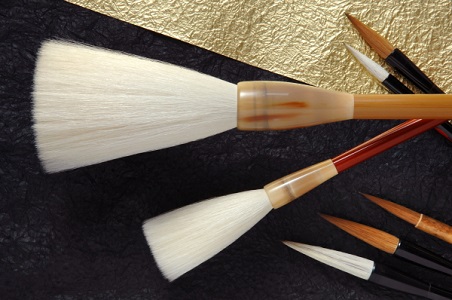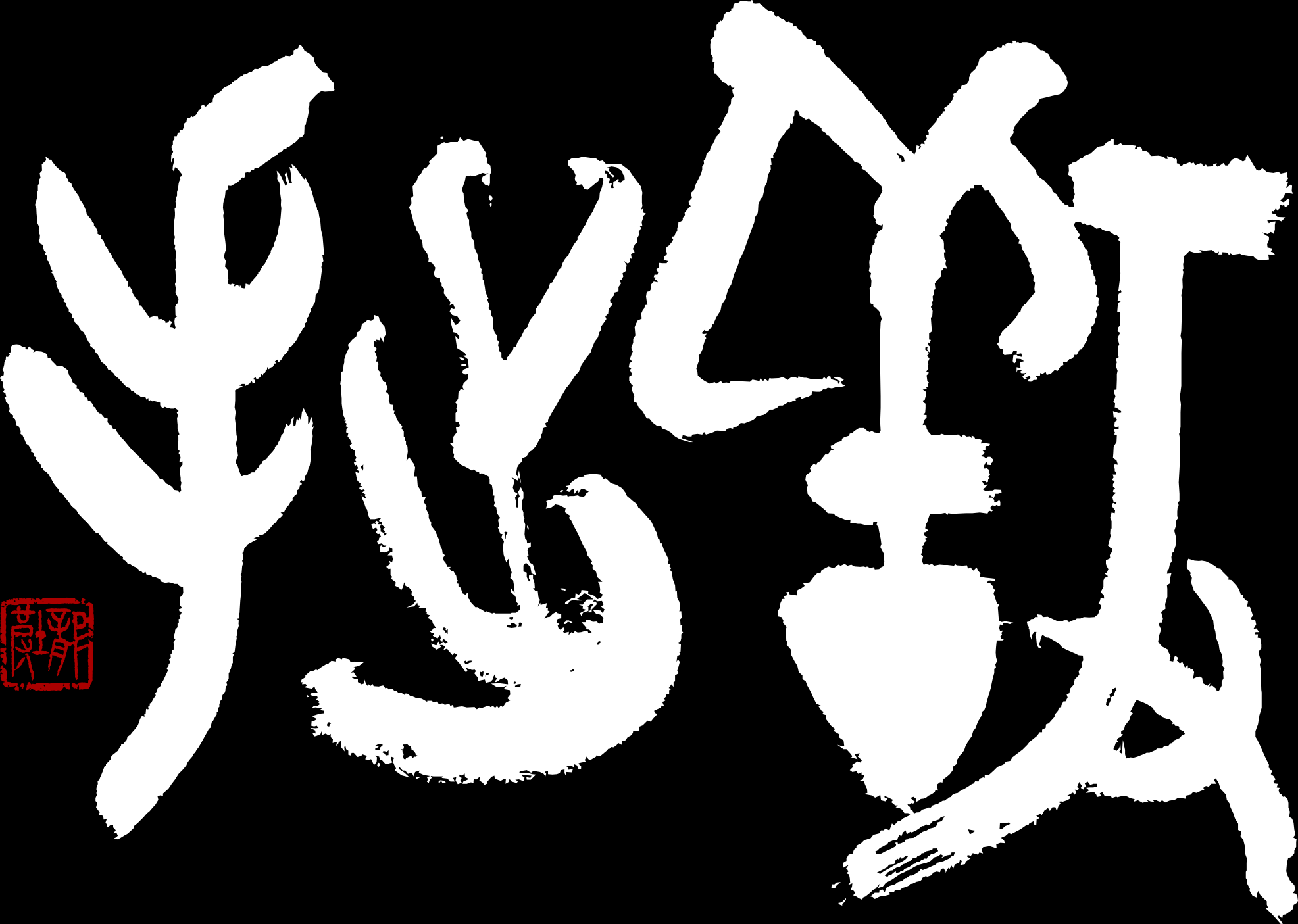Brushes are the fundamental tools of Japanese and Chinese calligraphers. Although there are innumerable ways to transfer ink onto a page through the motion of one’s arm or hand—including using a matchstick, a piece of tissue paper, or even one’s fingers—a brush is the most usual choice in Japanese and Chinese calligraphy.
Unlike Western calligraphy, in which quills or metal nibs are used, brushes have been the principal writing tools for the majority of the history of Japanese and Chinese calligraphy. As both Western calligraphy and Japanese and Chinese calligraphy employ ink and paper, the choice of writing tool is clearly the fundamental difference between the two.
In the hands of a highly experienced calligrapher, the hard tip of a quill or a metal nib can produce breathtaking results. However, it does not have the softness of a brush. Very often it is the unpredictable arrangement of the hairs which make up a brush tip that lend beauty to a line, while the range of expression afforded by a soft brush is essential to creating a dynamic piece of work with varied line weights and speeds. The springy, organic nature of the brush is central to both the appeal of Japanese and Chinese calligraphy and to the shapes of the characters that have evolved.
It is interesting to note that whereas in English, the term “brush” is very broad—referring to something that a watercolorist might use to add delicate petals to a flower, a decorator might use to recolor a wall in lightning-quick time, or we all might use to remove dirt from our teeth, our shoes, or a hard floor—in Japanese, a distinction is made between the types of brush used for polishing (束子, tawashi), those used for spreading pigment over a wide area (刷毛, hake), and those used for writing (筆, fude).
Although the earliest examples of Chinese calligraphy are carvings in bone or tortoiseshell, we know that brushes have been in use for well over 2,000 years. The oldest surviving fragment of brush-written calligraphy is nowhere near as old as this, but we can find evidence for it in the language itself: The character used for counting books (冊, satsu) is a pictograph showing strips of wood or bamboo joined together by pieces of string. These would have been written on using a brush (as all the many surviving examples were). However, the use of this character predates the oldest surviving brush-written characters.
Even though brushes were supplanted by pens, pencils, and typed characters as the principal everyday writing tools during the 20th century, for over two millennia, brushes defined the shapes of the lines used in kanji (and later, kana) characters and consequently the shapes of characters themselves.
Brush size
Anyone visiting a calligraphy supplies store will be confronted by a mind-boggling array of different fude (writing brushes) to choose from. One obvious difference between brushes is their size; in particular, the size of their tips. This can vary enormously, and the size of brush that you choose depends upon the width of the lines that you wish to write.
Broadly speaking, we can subdivide brush size into four categories.
- Fine brushes: These are used for writing characters no more than 2 or 3 centimeters in height. They are most commonly used for writing hiragana (ひらがな: cursive Japanese script), doing shakyō (写経), and signing larger pieces of calligraphy.
- Medium brushes: These are the most commonly used brushes, especially for beginners, and are used to write characters about 10 centimeters in height, usually on hanshi (半紙).
- Large brushes: These are used to produce characters from approximately 15 to 50 centimeters in height, usually on larger pieces of paper for exhibitions.
- Super-large brushes: The tips of these brushes are made from horses’ tails, and they are normally only used by expert calligraphers for special demonstrations. These super-large brushes are incredibly difficult to control and use huge quantities of ink, so it is quite rare to see one being used.

A selection of different-sized brushes.
Hair type
Another difference between brushes is the type of hair used in their tips. Commonly used sources of hair include:
- Sheep or goat
- Horse
- Weasel
- Wolf
- Deer
There are more outlandish types, including peacock feathers and bamboo split into fine strands. It is not uncommon for brushes to be made of human hair, either. However, the hair needs to be straight and never to have been cut. (The tip of a cut hair is squared off, which produces “scratchy” lines, whereas an uncut hair’s tip is rounded and produces softer, smoother lines.) Japanese parents will sometimes let their newborn child’s hair grow until it is long enough to produce a brush of decent size before taking the child to a hairdresser. The hairdresser will arrange to have the first cut sent to a brush maker. (It should be pointed out that such brushes are usually just kept as sentimental decorations; they are much too precious to be used for calligraphy.)
The type of hair has a big effect on how easy a brush is to use and the quality of lines it will produce. Firmer types, such as horsehair, keep their shape while they are being used, making it easier to control the shape of the lines produced. However, they can often be “scratchy,” leaving unwanted additional lines, and the range of different line types they can produce is limited. Softer types, such as sheep or goat hair, will become distorted as they are used, making it very difficult to write neatly. But this is precisely their appeal to more experienced calligraphers: a soft brush will yield unpredictable and organic lines. They also offer a much broader range of line qualities.
The tip of the brush is how the calligrapher transmits his or her energy onto the page. It is important that the reaction between the brush and the paper is transmitted back to the calligrapher so that he or she can in turn make the fine adjustments to his or her pressure or speed to produce the quality of lines which he or she desires. The way that this reaction can be most keenly felt is if the tip of the brush is acting as a spring—rather in the same way as the needle of a record player transmits its tiny movements through the compression and extension of the flexible metal arm to which it is attached, thereby producing beautiful and complex sounds. Indeed, you will often hear calligraphers talking about the bane (バネ), or spring, of a brush.
Regardless of your level, you will write your best calligraphy when the spring in your brush is engaged (バネ が効いている, bane ga kiite iru). The type of hair in the tip of your brush will determine how easy or difficult it is to engage the spring. With a firm brush, it is quite straightforward. However, with a very soft brush, it takes much more practice in order to be able to engage the spring and develop the sensitivity to be able to feel and respond to it.
Arguably the best brushes for beginners are made from a combination of different types of hair. These are known as kengō (兼毫) or kenmō (兼毛) brushes. The hairs in the core of the tip are firm—usually horsehair—giving the brush a good spring. The hairs on the outside are soft sheep or goat hair, which produce pleasing, smooth-edged lines.
Brush quality
The final significant distinction between brushes is the quality of the hair used in their tips and the level of craftsmanship that has gone into their production.
Better quality brushes will not only be nicer to use, they will usually last longer, too (although the lifespan of a brush is also determined by how well it is looked after). The hairs in the tip of a cheaper brush are often not well attached to the brush’s handle. As a result, such a brush will constantly shed hairs, which can be a distraction while you are writing. Some cheaper brushes also seem to be more difficult to clean thoroughly. This maybe because the poorer-quality hairs are not particularly smooth, so ink is left in the microscopic grooves in the hairs. This residual ink at the base of the hair soon builds up and causes the tip to “fork” (split into multiple points).
Given the range of brushes available and the large number of different brush makers, it can be difficult to choose a good brush. The recommendations of fellow calligraphers are of course very helpful—particularly if the style of calligraphy they are writing is similar to yours. But at the end of the day, trial-and-error over a long period of time is the best way to find the brushes that suit you.
One thing to bear in mind is that brushes need to be broken in: you need to use, clean, and reuse a brush several times before it will start to behave consistently. Don’t give up on a brush just because you didn’t like it the first time you tried it. What’s more, you need to give yourself time to get used to the brush. If, after a few attempts, the brush does not seem to be working well for the style of calligraphy that you’re practicing, put it away somewhere safe—it may be that it is just right for a different style.
